|
A low murmuring and the rustle of wet rain gear woke me from a light sleep. The
French group had returned to the Diesel Hut, our base camp, after an unsuccessful
summit attempt. High winds, poor visibility and horizontal hail at 5,000 meters had
forced their retreat. Nothing new, no one had summitted in the past month.
I rolled over in my sleeping bag, slightly dejected. We had spent a week
acclimatizing, and were running out of time. If the weather didn't improve in the
next two days there would be no summit for us either.
Despite Mont Blanc's fame, Mount Elbrus, at 5,642 meters above sea level is in fact
Europe's highest mountain. Set in the Caucasus range of mountains sandwiched between
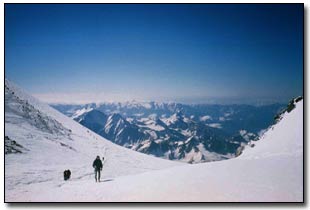 Russia and Georgia it lies on the European continent and extends significantly
higher than Mont Blanc's 4,810 meters. Although considered by serious mountaineers
to be nothing more than a "snow plod", the mountain is a challenging undertaking and
claims a number of lives every year. In the month prior to our trip at least five
people were reported lost or dead on the mountain.
Russia and Georgia it lies on the European continent and extends significantly
higher than Mont Blanc's 4,810 meters. Although considered by serious mountaineers
to be nothing more than a "snow plod", the mountain is a challenging undertaking and
claims a number of lives every year. In the month prior to our trip at least five
people were reported lost or dead on the mountain.
The acclimatization hikes had done their job and none of us were suffering any
effects of altitude sickness. A greater risk was lurking just outside the hut
however. The toilets outside the hut at base camp are infamous. Two wooden shacks
side by side with drop holes that, defying gravity, allow matter to fall up as well
as down. Key decision factors in the choice of which toilet to use are wind speed
and direction. Choose the wrong one and you may end up drenched in your neighbors
liquid waste!
Having been forced to spend three days at the Diesel Hut due to the weather we were
keen to get going and have a crack at the summit. The return of the French group, an
apparently strong group of experienced climbers, was therefore all the more
disconcerting. The following night was our last chance to attempt the summit, and
their defeat at the hands of the mountain did not bode well for our ascent.
The alarm didn't even get a chance to sound. It was 1am, I had been in bed since
9pm, but hadn't slept a wink. Nor had any of our group by the sounds of things. John
had caught a stomach bug the previous day (the toilets caught the blame!) and was
looking distinctly green. The eight of us dressed quickly and silently and slipped
down the steps to the kitchen for what was an extremely early breakfast.
I decided to brave the terrors of the hut "facilities" and wandered outside. Looking
up at the stars sparkling in a clear sky, I couldn't believe our luck. I was looking
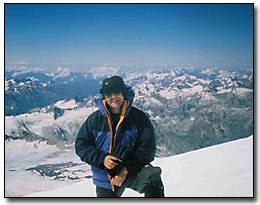 at the first clear sky over Elbrus in a month. It was too good to be true! "Well
God, are we going to make it tonight?" I asked skywards. A shooting star shot from
right to left in response. I remembered my classics studies, good omens come from
the right, bad omens come from the left. Slightly spooked, but certainly cheered, I
concluded my celestial inquiries and returned to breakfast.
at the first clear sky over Elbrus in a month. It was too good to be true! "Well
God, are we going to make it tonight?" I asked skywards. A shooting star shot from
right to left in response. I remembered my classics studies, good omens come from
the right, bad omens come from the left. Slightly spooked, but certainly cheered, I
concluded my celestial inquiries and returned to breakfast.
For the sake of esprit de corps I had to swallow my pride earlier that day. A vote
had been called on whether we should hire the "SnowCat", a Caterpillar vehicle, to
take us to the Pastukhov Rocks (4,700m), thus saving us an hour's hike, or start the
ascent from the Hut. The Purist in me rejected the SnowCat as cheating, but the
others concluded that as we had already done that part of the mountain the previous
day, we should simply take this shortcut. Outvoted seven to one, I was forced to
relent.
At 2am the SnowCat arrived, people and rucksacks piled on and soon the Diesel hut
was lost in the darkness. After a painful 15 minutes being carted uphill at a 45
degree angle, the deafening noise of the engine dropped signifying our arrival at
the Pastukhov rocks and we could all winch our way free of the contraption. Ice axes
were unlooped from bags, crampons were booted and with a silent air of concentration
the ascent proper had begun.
The first two hours of the climb are quite steep and strenuous. The scrape of
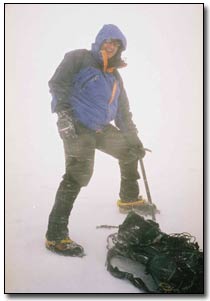 crampons from ahead gives advance warning to "kick in" harder to avoid a slip. A
reassuring "crunch" of crampon and ice-axe confirms that you kicked in hard enough
and at the right angle, so you're safe for the next three seconds at least.
Recovering from slips and stumbles is exhausting at this altitude, and is to be
avoided at all costs.
crampons from ahead gives advance warning to "kick in" harder to avoid a slip. A
reassuring "crunch" of crampon and ice-axe confirms that you kicked in hard enough
and at the right angle, so you're safe for the next three seconds at least.
Recovering from slips and stumbles is exhausting at this altitude, and is to be
avoided at all costs.
After three hours climbing through the black and white moonlit landscape, we reach
5,000 meters and the route levels off. As we reach the Saddle the sun bursts over
the mountains behind us and we are treated to a mesmerizing sunrise over the
pristine white landscape.
Although the climbing is now easier, the first hardships of operating at this
altitude begin to impact on our little group. John's stomach upset has reduced his
energy to the point where he can no longer continue. Even with the sun now up and
wearing plastic boots, Stuart gets frozen feet and can no longer feel his toes.
Fearing frostbite, he decides to turn back and try to catch up with John on the
return. Susan is suffering dizzy spells, bringing difficulty in balance and focus.
James has to make a run for it and let loose his diarrhea virtually in full view of
us!
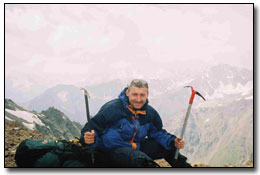 Having previously been through similar experiences on other climbs, I have settled
into a routine and am thankfully not suffering as I have before or as my compatriots
are now. My world is now limited to the footprints of the person in front of me,
encircled in a pool of light cast by my headtorch. I try not to look around too
much, as a stumble on the snow combined with a strong gust of wind would be certain
to throw me off balance.
Having previously been through similar experiences on other climbs, I have settled
into a routine and am thankfully not suffering as I have before or as my compatriots
are now. My world is now limited to the footprints of the person in front of me,
encircled in a pool of light cast by my headtorch. I try not to look around too
much, as a stumble on the snow combined with a strong gust of wind would be certain
to throw me off balance.
I focus on my breathing and pace, making sure that both are in sync, so that my
heart rate is steady. At this altitude the slightest deficiency in air to the lungs
can have a serious impact on your heart rate, and therefore performance, within
seconds. I am also drinking as much fluid as possible even though I'm not thirsty.
Dehydration is a major factor in altitude sickness, and I know that shortly the
tube running from the bladder in my rucksack to my mouth will freeze and it will
not be so easy to hydrate. Nonetheless, I can feel the pounding in my head
increasing, and know that the slightest increase in heart rate will bring on a very
painful headache and nausea.
At 5,200 meters I start to grow concerned about the fact that I haven't been able to
feel my toes for the last half hour. I take off my boots and Gia, our guide, whips
them with his mittened hand until I can feel pain again. Pain, it seems, is good!
Strangely, I actually start to feel better the higher we go. My body seems to be
adapting more quickly than usual to the altitude and at 5,400 meters it is clear
that I am suffering the least of the entire group. Even Andrew, my marathon running
friend, now seems to be suffering and I sit with him for some time while he
re-energizes.
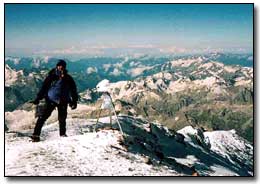 But at this point, the Holy Grail is within view. The summit is just over an hours
climb from here and nothing can stop us now. Time seems to pass more quickly and
before we know it we have reached the bottom of a small hillock. Less than a
minute's climb and…
But at this point, the Holy Grail is within view. The summit is just over an hours
climb from here and nothing can stop us now. Time seems to pass more quickly and
before we know it we have reached the bottom of a small hillock. Less than a
minute's climb and…
It is a perfectly clear morning at 9am local time. We are standing on the top of
Europe and can see for miles. We embrace and congratulate each other to the sound of
our camera clicks, and for a short time savour what must surely be one of the most
impressive views in all of Europe.
|

